Menu
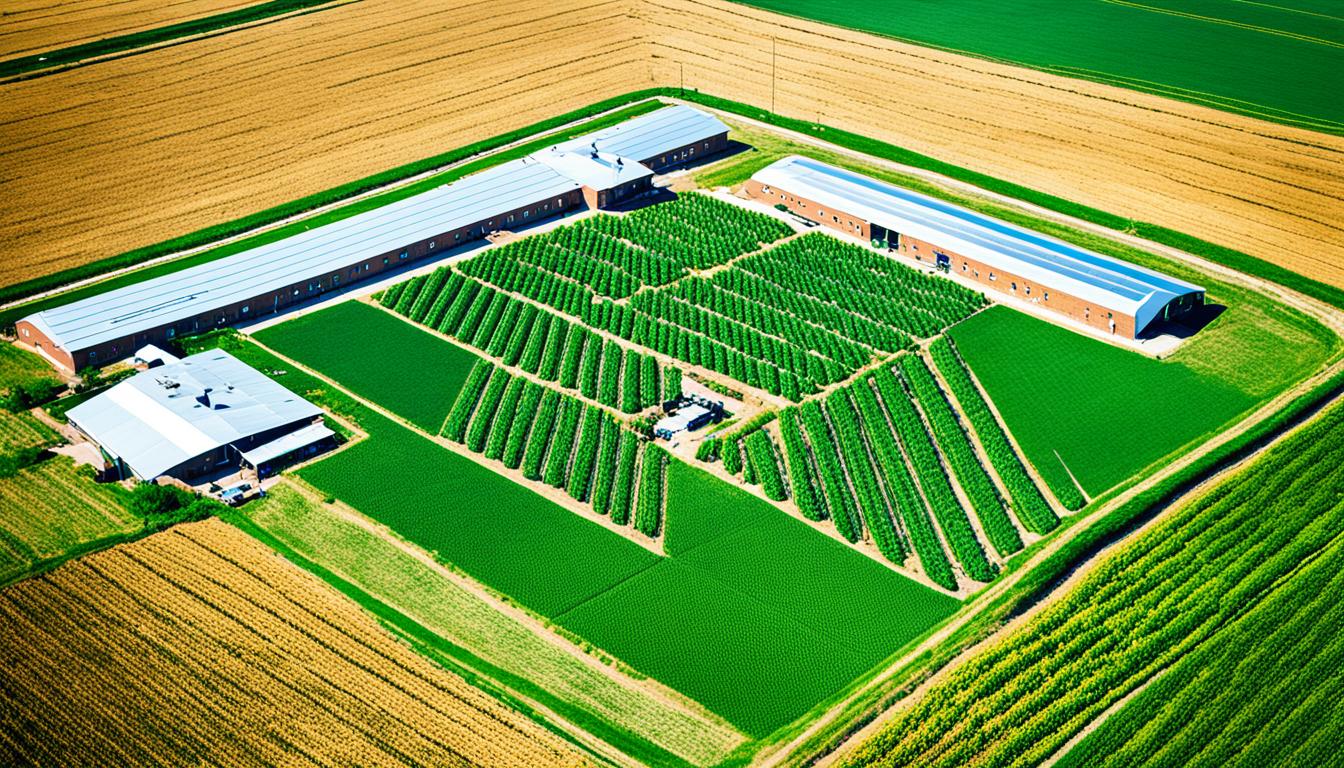
Did you know schools and farms sometimes work together closely? They do more than share farming tips or buy tools together. With fewer teachers in farming, hands-on learning is more essential than ever. Collaborations between schools and farms help fill this gap.
In Virginia, Ferrum College and Farm Credit University teamed up. They offered an online course, Ag Biz Planner, to twenty-six students. These students learnt about business planning and improved how they communicate. At their graduation, everyone noticed a positive change. They dressed smarter, shook hands firmly, made eye contact, and spoke more clearly. This shows how working together benefits students’ skills and professionalism.
Educational collaborations are key in filling the gaps in agribusiness education. There’s a lack of agribusiness teachers, so we need educational programs in rural schools and strong partnership schemes with educational establishments. This makes it vital for students to learn.
Universities working with colleges boost students’ skills. They get to learn on real farms and businesses. This helps them be top in the agribusiness world after they finish studying.
In Canada, farmers team up in groups to share tips and set high standards. Last year, 70% of small canisters were collected at 1,000 places thanks to their teamwork.
Students also benefit a lot from these projects. For example, at the University of Waterloo, students can try out different jobs while they study. This gives them real-life skills before they even leave school.
Young people, like Bailey Pryce, work with groups to help the farming world do better. These jobs make them eager to use methods that protect our planet.
But these projects do more than just help students. They help teachers, too. A study showed that new teachers learn better by working together early on. This supports the idea that we build our knowledge through social connections, a theory by Vygotsky.
These points show why educational programs in rural schools and strong partnership schemes with educational establishments are crucial. They help us grow future farm experts who are skilled and ready for challenges.
School-farm collaborations offer many benefits to students. They turn what they learn in class into real-life experience. These projects help students see the link between what’s taught in school and what happens on a farm.
These collaborations give students hands-on practice with agriculture. They get to use what they’ve learned in subjects such as biology and maths. And, they get a real feel for how they can impact their environment.
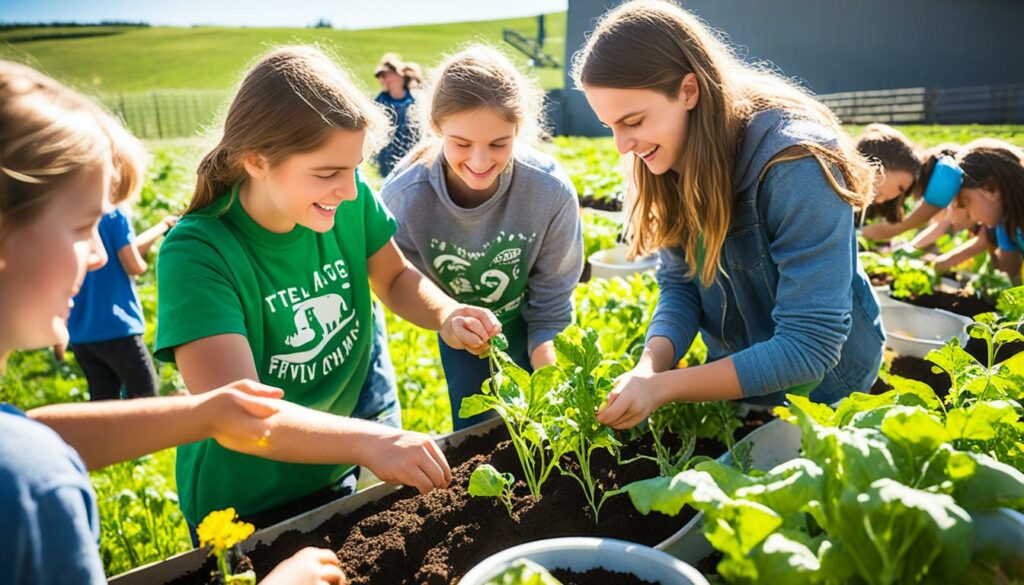
Setting up a farm area at school is key. It should get plenty of sunlight and have good soil. This kind of space lets students work with nature and see the direct results of their work.
Students team up with the agricultural sector on projects. These school-farm collaborations let them work on tasks that match what they’ll face in jobs later. They learn how to make real plans, ask important questions, and manage teamwork issues.
Such real-world projects are key for students’ growth. They gain skills that help in school and future jobs. They learn to think critically and solve problems by dealing with real-life challenges.
The most important part of these projects? The chance to work with others. Students learn how to be part of a team. They get better at communicating, managing group problems, and reaching shared goals. This prepares them to face the world ahead in many ways.
Bringing in community members like parents and local farmers enhances the experience. It helps take care of the farm at school. Plus, it brings the community and the school closer, showing how they can work together and share duties.
| Benefit | Description |
|---|---|
| Enhanced Learning | Practical experiences deepen understanding and connect students to the environment. |
| Real-World Skills | Students develop business plans and teamwork skills, preparing them for professional challenges. |
| Community Involvement | Engages parents, local farmers, and volunteers, strengthening community ties. |
In summary, by working together with the farm sector, schools provide big learning chances. Students get to really understand farming, learn how to work in a team, and get involved with their community. All this helps them get ready for a bright future in many different areas.
Creating strong links between schools and farms is key. It’s vital for great agricultural education and ties within the community. These connections also help local farm businesses.
Having good communication is crucial for school partnerships with farming communities. Educators, students, and farm owners need to talk openly. This ensures everyone knows their role and what’s expected of them. It also reduces problems and makes learning together more enjoyable. The USDA suggests using things like urban agricultural advisory committees. They can help meet the needs of urban farmers, improving everyone’s education.
Agreeing on shared goals makes partnerships stronger. Goals like creating school meals with local foods or supporting fair food systems. These goals push everyone to work well together. The 2019 National Food Hub Survey pointed out trends that help set important food hub goals. Connecting with the community lets schools and farms do big things. They can make local projects more active and show students the different paths in agriculture.
Vermont FEED has been very successful in teaching about agriculture. It links different groups through the Farm-to-School network. These include teachers, parents, and community members. This approach provides a full education experience.
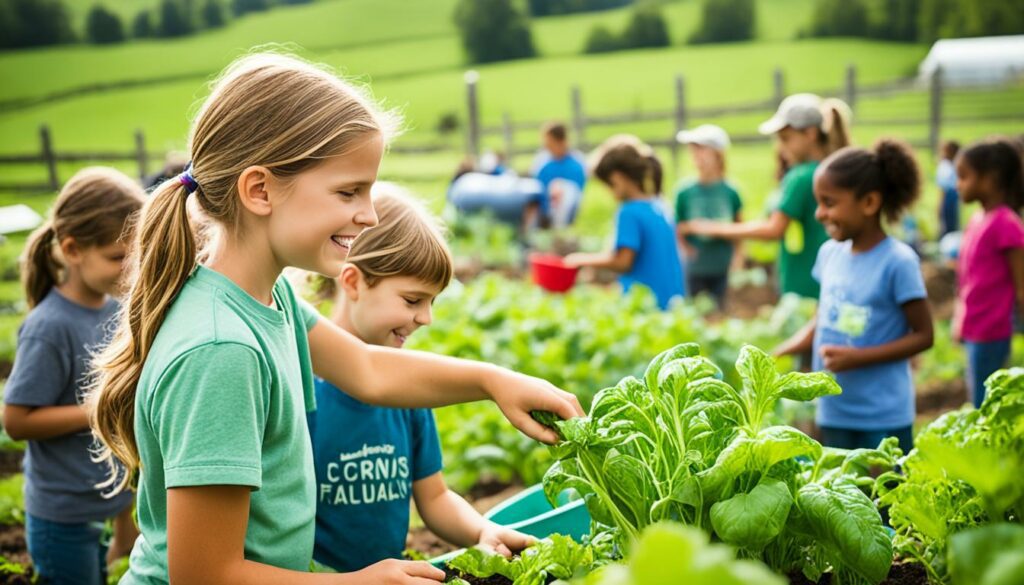
In Putney, there’s a school with 13 acres and more surrounded by woods. It focuses on local values and food sources. This matches Vermont FEED’s approach well. Other schools, like Hardwick Elementary and Milton High, also follow these Farm-to-School ideas. They give students in-depth agricultural lessons.
BFA Fairfax is successful with a 15-acre farm. They have gardens, an orchard, and more. This practical setup helps students turn knowledge into hands-on skills. It shows how learning together in agriculture can be very beneficial.
Putney Central is another example, leading in sustainability efforts. It has a committee working on sustainability goals. Their principal ensures these efforts are part of the school’s life. This helps students understand and practice sustainability regularly.
| School | Initiatives | Community Impact |
|---|---|---|
| BFA Fairfax | School farm with diverse agricultural projects | Engages students in practical agricultural activities |
| Putney Central School | Connecting with local food sources and sustainability | Supports local community values and promotes sustainability |
| Milton High School | Commitment to school innovation and student development | Reflected in the suburban community’s engagement with the Farm-to-School programme |
These projects boost more than just learning. They also help health, the economy, and the environment. Vermont FEED focuses on local foods and outdoor education. This shows how schools and local areas can benefit each other.
Yet, getting steady funds is tough. Vermont uses smart ways to manage its food budget and buy local. This model helps all families access fresh, local food. It sets a good example for other rural schools too.
Agricultural education initiatives make a big difference in rural areas. They connect education with farming, boosting learning and the economy. This is seen in the Farm to School Grant Program, which gives around $5 million each year. It helps schools and farms work together for the betterment of their communities.
School-farm partnerships create new markets for local farmers. With schools buying more local produce, the economy gets stronger. The USDA began supporting this in 1996, aiming to benefit local economies. Schools spend a lot on food, over $6.3 billion, and use a big part of that for local products. Oregon alone has put in nearly $10.4 million to support farm to school and school garden projects.
Helping children eat better is a key goal of these partnerships. In northern Florida, the USDA’s project brought fresh collard greens to schools. This effort was supported by local cooperatives, like the New North Florida Cooperative. Their work led to more local farm products in schools by 2000. A project in Georgia showed similar success. Today, over 30 million students benefit from the Farm to School movement, making school food healthier.
These partnerships do more than improve what kids eat at school. They help students understand more about food and farming. It makes learning hands-on and close to their communities. They learn why eating local and fresh is important.
| Impact Area | Statistic |
|---|---|
| Economic Boost | $6.3 billion on school meal food costs |
| Funding Allocation | $10.4 million in Oregon, $1 million in New York State |
| Child Nutrition | Daily nutrition for over 30 million students |
| Program Participation | 42% of U.S. schools engaged in farm to school activities (2015) |
These numbers highlight how important it is to mix farming with education in rural areas. It helps communities in lasting and positive ways.
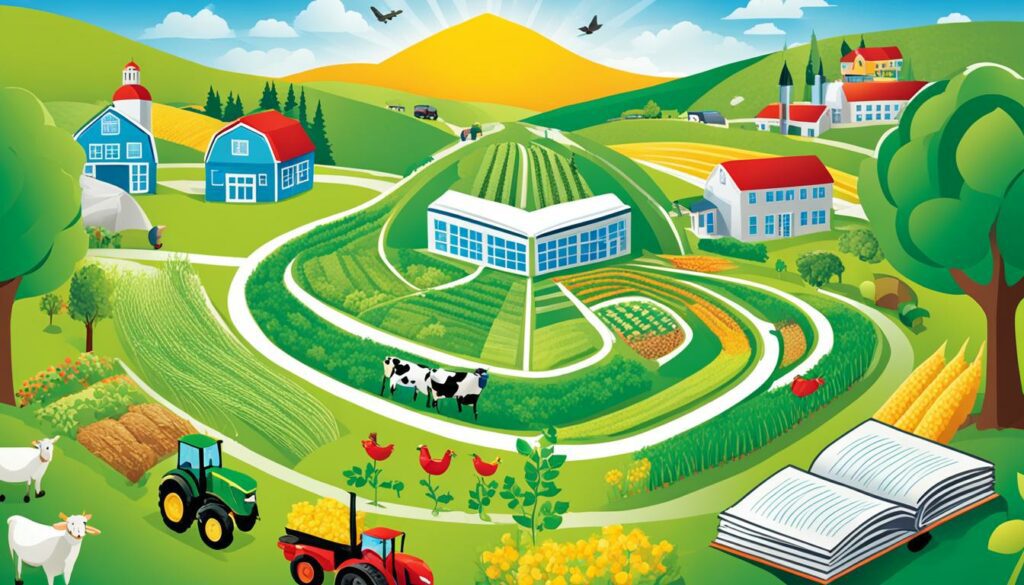
Ferrum College is leading in boosting educational growth. It’s working with Farm Credit University. This partnership mixes online classes with group projects. Students learn about business planning.
They get tips from agribusiness pros. This approach blends hands-on experiences with book learning. It’s a complete education package.
Students benefit from meeting mentors. They also get a solid grasp of the farming world. Working with Farm Credit, they put theory into action. This prepares them well for farming careers ahead.
This effort shows how such alliances can groom future farming leaders. Ferrum uses a mix of lessons and doing things. So, students are set to meet today’s farming challenges head-on.
Here are some important statistics to help you understand better:
| Institution | Specialisation |
|---|---|
| Warren Wilson College | Top-ranked for farming |
| College of the Ozarks | Top-ranked for farming |
| Dartmouth Organic Farm | Ranked 35 in the list of farming colleges |
| Cal Poly | Operates a nine-acre certified organic farm |
| College of the Atlantic | Operates two campus farms |
| Duke University | Supplies thousands of pounds of fresh produce to campus dining halls |
| Earlham College | Focuses on sustainable living and explorative learning |
| Penn State University | Operates farms for teaching agricultural sciences and farm management methods |
| Sterling College | Integral part of its educational programme, supporting practical learning in farming and sustainability |
The table highlights many partnership schemes. These are between schools and agriculture groups. These efforts deeply enhance the learning experience for students.
Bringing agricultural teachings into schools is now key for student growth. It helps improve both academic and practical skills. Schools that focus on real-life learning notice big boosts. Kids get more into it and grasp complex science better.
Research from Freight Farms finds that farming at school makes students really into science and tech. This happens when we add agricultural lessons to school work.
Doing things in real life, not just studying, makes a big difference. A school in California saw science scores rise by 30% with farming projects. This proves getting hands dirty helps students do better in school.
Freight Farms’ high-tech farming uses a lot less water. It teaches students about using water wisely. Learning this way makes them understand nature and how food grows. A study in the “Journal of Environmental Education” backs this up.
Teaching farm theory alongside practice makes a real difference. Schools see students enjoy learning more and come to school more often. This way of teaching improves study skills that help a lot in science and technology.
Farms at schools also teach about working together and caring for the environment. The Living Greens project gets lots of local people involved. It makes schools and communities closer.
Integrating farming in schools makes learning rich and full. It mixes good study with practical life skills. This is important for jobs in farming and other areas. Even schools in cities can do it with small farms. This makes it all possible.
Non-profit organisations play a key role in educational partnerships. They connect academic groups with those in agriculture. This connection brings in resources and expertise that boost learning for everyone involved.

Vermont FEED stands out by linking schools with farming through the National Farm to School Network. It reaches out to 54,000 students and has 74 schools in its programs. It helps combat child hunger, affecting over 20 percent of kids in the area.
In states like Massachusetts and Vermont, where many kids need food help, these programmes are vital. Hunger can hurt how well kids do at school. For instance, 85 percent of students at Mount Pleasant High in Rhode Island get free or reduced lunches. Many of these students face hunger and fatigue, which affects their learning.
Organisations like Vermont FEED are making a difference. They started the Agricultural Academy at Mount Pleasant High. They improved the food and lesson plans, and got the local community involved. This makes agricultural education a core part of school life, linking what students learn with the real world.
The Northeast Farm to School Collaborative is another key player. It helps create a network where schools learn from each other about farming. This lets students see agriculture up close, building community spirit and teaching vital skills for working in agriculture in the future.
These groups offer grants up to $100,000 for projects that work well and are sustainable. Schools, tribes, and non-profits must match 25 percent of the funds. This helps start and keep up agriculture education programs.
Non-profit organisations are vital in spreading agricultural knowledge. They help students and whole communities learn and grow. This shows how big their impact can be.
Building strong partnerships between schools and farms is a big task. It involves putting together plans that take care of how things will work and finding enough money and resources. It’s all about making sure the right people are working together to create good learning opportunities for students.
Fruits and veggies often travel thousands of miles before we eat them. This means there are big challenges in getting fresh produce to schools. To fix this, school-farm projects should make their delivery systems better. They can do this by working with local businesses that help bring food closer to schools. By doing this, schools can offer students healthier and more delicious options.
Finding enough money is key for school-farm projects to succeed. Schools are already spending a lot, nearly $400 million, on local food. Yet, they need more help to keep their efforts running smoothly. To get financial support, stakeholders can look into different sources of money. This includes grants, help from the local community, and investments from private companies. Having support from local leaders in food can make a big difference. Thirteen such folks, from places like Michigan and California, can work with others to show off what these partnerships can do for their communities and students’ health.
Nutritional education is key in rural schools’ teaching plans, offering benefits that last far beyond lessons. It’s all about teaching students to eat healthily, understand where food comes from, and why locally grown food is great.
The Farm to School programme is critical here. It provides grants up to $100,000 for nutrition projects, with schools and communities also pitching in. They focus on getting local food into school meals, especially helping kids who need it most.
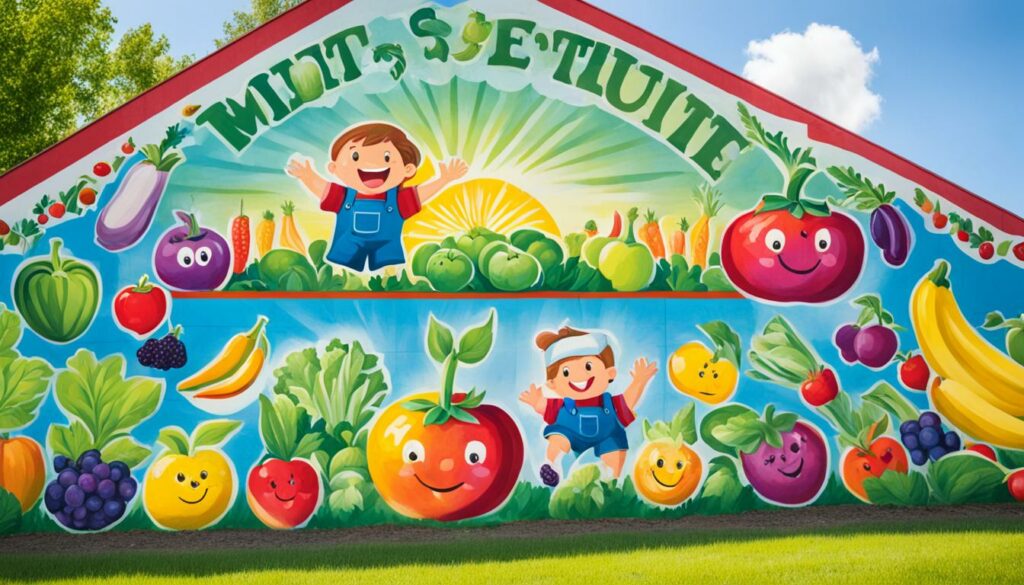
These programs help rural kids learn about agriculture and food. This is vital because many children in the US struggle with obesity or not having enough to eat. By teaching them well, we hope they’ll choose a healthier life.
The USDA found that 42% of schools now do farming activities, showing it’s becoming more popular in education.
The success of the program involves many partners, including schools, NGOs, farmers, and local groups. This team effort helps the lessons stick and ensures they keep going.
Having school gardens, for example, has been great for getting kids to eat more fruit and veg. It’s even linked to better grades. Plus, using these foods in school meals makes the food better and gets students more interested in farming as a career.
| State | Farm to School Program Funding |
|---|---|
| Oregon | $10.4 million |
| New York | $1 million to 12 programs (January 2018) |
Programs like the Dairy Council of California’s Let’s Eat Healthy help millions every year, showing the clear impact of such education. In this case, it reached many Spanish speakers, making it very inclusive.
To sum up, teaching about nutrition in rural schools is not just about information. It’s about making our communities healthier. The work they do now will echo in the future, showing the real value of these efforts.
The evolution of the Farm to School movement connects education with farming. It started to link food production and learning. This movement has gone through many changes. The history and current trends help us understand how it’s grown and adapted.
The roots of the Farm to School movement are from the early 2000s. Back then, communities wanted to bring local food to schools. They aimed to help local farmers and encourage students to eat healthily. By 2005, more than a thousand farm to school programs were happening across the country. These programs wanted to make people healthier and boost learning. Interestingly, while revenue from farmers’ markets has either gone up or down, some places have changed how they get farm products.
Today, Farm to School efforts are more organised and many schools are working together. Schools with these programs see that 28% more students pick healthy foods. Lots of schools also now buy local foods, spending around $789 million. These efforts mean that 42% of schools in the US do farm to school programming. This helps over 23 million students each year.
In the future, the focus is on making these efforts last and grow. Programs want schools and farms to keep working together, helping each other. They want to create a strong educational network. More and more people are getting involved. They work together, like the Northeast Farm to School Collaborative. This shows we are moving in a good direction. Adding business and entrepreneur lessons to school plans also helps. It gets students ready for life after school. It teaches them things not only from books but from real experiences.
Considering the past and present of the farm to school movement, it’s clear. These projects boost healthy eating. But they do much more. They help in education and build strong communities. This ensures that the movement keeps growing and making a difference.
Collaborative learning projects in farming have been very successful. They connect what we learn with how we farm. For example, 17 teachers met online from Chicago and Milwaukee. They were trained over two days on how to teach better.
This was part of a bigger plan by Anderson to improve farming education. Thanks to a $300,000 grant, he trained over 191 teachers virtually over the summer. These efforts are making farming lessons more understandable and fun for students.
Anderson’s big plan is turning teacher training into a regular thing for those who teach farming. This plan relies on many teams working together. They aim to make sure the next teachers know a lot about food and how to care for our planet.
Furthermore, these projects have helped create lasting friendships and a strong support network. Leaders like James Anderson are working hard to keep these projects going. As more people join from different places and backgrounds, farming education becomes more complete.
A: Collaborations between schools and farms offer students real farming experiences. It makes learning more practical and helps students understand agriculture better. This prepares them for agricultural jobs in the future.
These initiatives help rural areas by boosting the economy and improving kids’ diets. Partnerships between schools and farms teach kids to eat better and support local agriculture. This makes for healthier choices and supports local farmers.
By working on farms, students learn about agriculture first-hand. They also get to apply what they learn in class to real situations. Group projects and teamwork on farms help teach students important business and life skills too.
Good communication is key for strong partnerships. It’s important to talk often, set clear goals, and keep the focus on shared benefits. These steps help connect communities and support local farming.
A: Vermont FEED shows how well school-farm projects can work. By linking kids’ food, local economy, and education, they make a big impact. For instance, farm visits help show the good things these partnerships do.
Schools working with agribusinesses help fill the gap in teaching. Apply experiences add to what students learn in classes. This way, more students get ready for jobs in agriculture.
Ferrum College’s link with Farm Credit University stands out. It mixes online lessons with projects focusing on planning. Students get advice and hands-on lessons from local farms. This helps get them ready for their future farm careers.
Non-profits bring knowledge and support to mix farming and schools. Groups like Vermont FEED help set up programs that let students experience farming. This helps both education and the community.
Problems in school-farm projects might include how to manage and get ongoing funding. These issues need careful planning and a lot of support. Looking for grants and local help can keep the programs going strong.
Learning about food with farms leads to better eating habits and food knowledge. This lasts a lifetime, improving health and food choices in the community. It makes for a healthy and eco-friendly place to live.
The Farm to School idea has grown to cover more than just food and learning. Today, it’s about making big, lasting changes. This includes more support from the government, different subjects in school, and ways to help the whole community.
Trips to farms, learning by doing, and getting active with farming help students understand food better. These ways of learning spark thinking, and help students care for the earth and their community.
By letting students work directly with farming, they learn a lot. This way, what they learn in class makes sense in real life. It also helps students see job opportunities in agriculture.